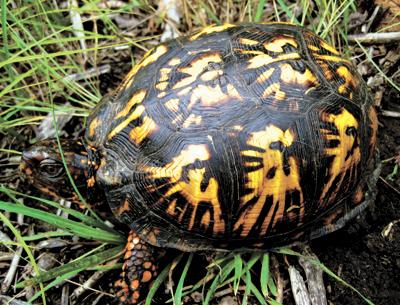Nature Notes: Slow, Steady Decline

What happened to all the turtles? Of all the years since 1974 that I’ve been riding the roads and watching out for them, this is the year I’ve seen the fewest.
The two species that regularly cross roads in late May and June, the eastern box turtle and snapping turtle have been few and far between. I have yet to count a single turtle roadkill in 2013.
Long Island has seven native turtles and three or four let-goes. Five of them are aquatic, the rarest of which is the mud turtle. It is found here and there, primarily in wetlands near the bays and tidal creeks. Robbins Island has a small population. The next rarest is the spotted turtle. The New York State spotted turtles are concentrated on the South Fork, particularly on Napeague and in Montauk.
The most common aquatic turtles are the painted turtle and snapping turtle. Almost every pond has both, or, if not, one or the other. Painted turtles are the ones with the glossy black shells that you see sunning themselves along banks or on partially submerged logs. You rarely see more than the large head of the snapping turtle as it silently lurks below the surface, but during the egg-laying season, mid-May to mid-June, you will often see one of these 20-pounders, invariably a female, sluggishly crossing a back road on its way from her watering hole to a spot of sandy land to dig in with her hind feet and lay 5 to 10 eggs, then cover them up with loose soil using the same feet she dug with.
The gravid snapping turtle may travel hundreds of yards to find the right spot, while the gravid painted turtle generally travels less than 50 feet before ovipositing.
Two more amphibious turtles occur throughout Long Island — the musk turtle, which is sort of a tree or low-bush climber of freshwater pond edges, and the diamondback terrapin, the only marine turtle to breed on Long Island shores. The former has been known to drop into passing canoes and kayaks when dislodged from a sunning spot. The latter rarely ventures out into deep waters, say, like green turtles, loggerheads, ridleys, and leatherbacks, the largest of all turtles, but instead sticks to tidal creeks, bays, brackish lagoons, and the like. Females generally lay their eggs on sandy spits or low dunes along the Peconic and Great South Bays, but almost never on ocean beaches.
The native qualifications of another amphibious turtle, the red-bellied turtle, are in question in the same way that mountain lions are in northern New England and New York. Only a trained herpetologist is allowed to make the call on the redbelly, but several lay sightings have been reported. One of them, a female laying eggs in the Long Pond Greenbelt main trail, was photographed by Jean Held, a naturalist, several years back. Chris Chapin, Brian Frank, and I have all observed red-bellied turtles on the South Fork at one time or another. They look like large painted turtles but are reddish on the plastron, or bottom shell, instead of yellowish.
Then there are the sliders and red-eared turtles that have been purchased from pet dealers and let lose in Long Island waters by the carload. They are more southern in natural distribution, but seem to do as well here as the natives. Town Pond and Hook Pond in East Hampton have their share of these two let-goes, as do Lake Agawam in Southampton Village and Mill Pond in Water Mill.
The eggs that are laid in the late spring don’t usually hatch out until mid-fall. In many cases the hatchling box turtles and diamondbacks don’t leave their underground cribs until the following spring when the ground warms up. If, while walking along, you see a little group of pearly white bead-sized thin shells in the open, it is a good bet that you are looking at the remains of a predated nest. Raccoons are particularly fond of turtle eggs and are able to smell them out. Since, by modern day accounts, raccoons are locally much more common than box turtles and diamondbacks, it is believed that the majority of turtle eggs are plundered prior to hatching out. Snappers and diamondbacks are gastronomic favorites of various ethnic groups. The former is the only one that prays on baby ducks, geese, and swans in addition to fish and other aquatic organisms. It can bite off your little toe or pinky in the wink of an eye. When trying to save one from becoming a roadkill, it should only be approached from behind and even then very carefully.
The lack of box turtle sightings on the highways and byways this year might be a good sign that somehow, they have learned to stay away from roads, or a bad sign that there are fewer and fewer of them around with each passing generation. The first hypothesis is unlikely. Since box turtles have been known to outlive humans, and live as long as crocodiles, i.e., to become centenarians, it is a great tragedy when one is removed from the population. Like horseshoe crabs, but much younger evolutionarily, they are well protected by their shells in nature.
Moreover, unlike most turtles, they can completely secure themselves inside their shells, as the front part of their plastron is hinged and fits tightly, almost hermetically, against the forward under-edge of the carapace.
If box turtles could speak our language they could tell us a few amazing things, no doubt, like the time one out-legged a hare in a foot race.
